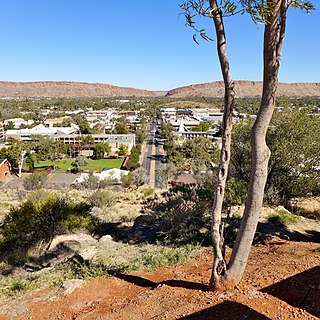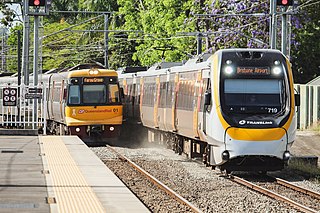Related Research Articles

Darwin is the capital city of the Northern Territory, Australia. With an estimated population of 147,255 as of 2019, the city contains the majority of the residents of the sparsely populated Northern Territory.

The Northern Territory is an Australian territory in the central and central northern regions of Australia. The Northern Territory shares its borders with Western Australia to the west, South Australia to the south, and Queensland to the east. To the north, the territory looks out to the Timor Sea, the Arafura Sea and the Gulf of Carpentaria, including Western New Guinea and other islands of the Indonesian archipelago.

Alice Springs known as Stuart until 31 August 1933, is the third-largest town in the Northern Territory of Australia. The name Alice Springs was given by surveyor William Whitfield Mills after Alice, Lady Todd, wife of the telegraph pioneer Sir Charles Todd. Known colloquially as 'The Alice' or simply 'Alice', the town is situated roughly in Australia's geographic centre. It is nearly equidistant from Adelaide and Darwin.

The Ghan is an experiential tourism oriented passenger train service that operates between the northern and southern coasts of Australia, through the cities of Adelaide, Alice Springs and Darwin on the Adelaide–Darwin rail corridor. Operated by Journey Beyond Rail Expeditions, its scheduled travelling time, including extended stops for passengers to do off-train tours, is 53 hours 15 minutes to travel the 2,979 kilometres (1,851 mi). The Ghan has been described as one of the world's great passenger trains.

The Adelaide–Darwin railway line is a railway line in Australia, between the South Australian town of Tarcoola and the Northern Territory city of Darwin. Preceded by a number of other shorter railways, a line through to Darwin was fully realised in 2004 when the final link from Alice Springs to Darwin was opened. Forming the main section of the 2,975 kilometres (1,849 mi) rail corridor between the cities of Adelaide and Darwin, the line is used by The Ghan passenger train and interstate freight trains operated by Aurizon.

Rail transport in Australia is a component of the Australian transport system. It is to a large extent state-based, as each state largely has its own operations, with the interstate network being developed ever since Australia's federation in 1901. As of 2022, the Australian rail network consists of a total of 32,929 kilometres (20,461 mi) of track built to three major track gauges: 18,007 kilometres (11,189 mi) of standard gauge, 2,685 kilometres (1,668 mi) of broad gauge, and 11,914 kilometres (7,403 mi) of narrow gauge lines. Additionally, about 1,400 kilometres (870 mi) of 610 mm / 2 ft gauge lines support the sugar-cane industry. 3,488 kilometres (2,167 mi), around 11 per cent of the Australian heavy railways network route-kilometres are electrified.
Australians generally assumed in the 1850s that railways would be built by the private sector. Private companies built railways in the then colonies of Victoria, opened in 1854, and New South Wales, where the company was taken over by the government before completion in 1855, due to bankruptcy. South Australia's railways were government owned from the beginning, including a horse-drawn line opened in 1854 and a steam-powered line opened in 1856. In Victoria, the private railways were soon found not to be financially viable, and existing rail networks and their expansion were taken over by the colony. Government ownership also enabled railways to be built to promote development, even if not apparently viable in strictly financial terms. The railway systems spread from the colonial capitals, except in cases where geography dictated a choice of an alternate port.

The Australian Rail Track Corporation (ARTC) is an Australian Government-owned statutory corporation.

Adelaide River is a small but historically significant town located at the crossing of the Stuart Highway over the Adelaide River in the Northern Territory of Australia. The town is upstream of the Adelaide and Mary River Floodplains Important Bird Area. At the 2016 census, Adelaide River had a population of 353. Adelaide River is part of the Coomalie Shire and is the second largest settlement in the local government area.

The North Australia Railway was a 509 km (316 mi) 1,067 mm narrow gauge railway in the Northern Territory of Australia which ran from the territory capital of Darwin, once known as Palmerston, to Birdum, just south of Larrimah. Initially its name was the Palmerston and Pine Creek Railway. The first section was opened 1889, the last in 1929. The railway closed in 1976.

Genesee & Wyoming Inc. (G&W) is an American short line railroad holding company, that owns or maintains an interest in 122 railroads in the United States, Canada, Belgium, Netherlands, Poland, United Kingdom and formerly Australia. It operates more than 13,000 miles (21,000 km) of owned and leased track. G&W owns or leases 116 freight railroads organized in locally managed operating regions with 7,300 employees serving 3,000 customers. The company had its roots in the Class III Genesee and Wyoming Railroad, which began in 1899.

The Commonwealth Railways were established in 1917 by the Government of Australia with the Commonwealth Railways Act to administer the Trans-Australia and Port Augusta to Darwin railways. It was absorbed into Australian National in 1975.
FreightLink was a railway freight operator in Australia that operated in the newly completed Adelaide–Darwin rail corridor between 2004 and 2010.
The Asia Pacific Transport Consortium is a consortium of three companies and a joint venture established to operate a railway in Australia.
Tennant Creek Airport is a small regional airport located near Tennant Creek, Northern Territory, Australia.

Rail transport in Tasmania consists of a network of narrow gauge track of 1,067 mm reaching virtually all cities and major towns in the island state of Tasmania, Australia. Today, rail services are focused primarily on bulk freight, with no commercial passenger services being operated. The mainline railways of Tasmania are currently operated by TasRail, a Government of Tasmania-owned Corporation, who owns and maintains both rolling stock, locomotives, and track infrastructure.

One Rail Australia was an Australian rail freight operator company. Founded by American short line railroad holding company, Genesee & Wyoming Inc, in 1997 as Australian Southern Railroad, and successively renamed Australian Railroad Group and Genesee & Wyoming Australia, it was renamed One Rail Australia in February 2020 after the American company sold its remaining shareholding. In July 2022, assets from the South Australian, Northern Territory and interstate operations of the company were sold to rail operator company Aurizon Holdings Limited. The remaining assets, relating to coal haulage in New South Wales and Queensland, were sold in February 2023 to Magnetic Rail Group.

The John Holland Group is an infrastructure, building, rail and transport business operating in Australia and New Zealand. Headquartered in Melbourne, it is a subsidiary of China Communications Construction.
East Arm is a suburb in the Northern Territory of Australia located in Darwin about 8 kilometres (5.0 mi) east of Darwin City overlooking a part of Darwin Harbour known as the East Arm.
The COVID-19 pandemic in the Northern Territory is part of the ongoing worldwide pandemic of the coronavirus disease 2019 caused by severe acute respiratory syndrome coronavirus 2.
References
- ↑ AustralAsia link making rapid progress Railway Gazette International 1 April 2002
- ↑ Australasia Railway Project AustralAsia Railway Corporation